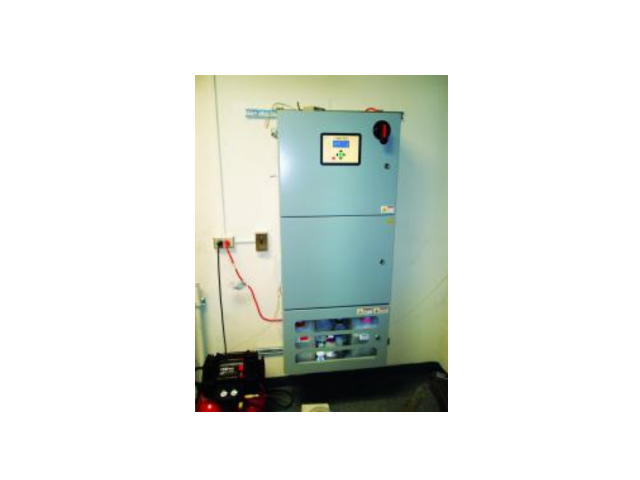Monitoring Old Bridge
By Michael Roy, P.E., and Rudy Mui
March 19, 2014
Online THM monitoring helps New Jersey water authority achieve DBP compliance
The Old Bridge Municipal Utilities Authority (Old Bridge MUA) serves the township of Old Bridge, Middlesex County, N.J., located across the RaritanBay from Staten Island, 25 miles from Manhattan and 30 miles south of Newark. Old Bridge MUA is responsible for supplying drinking water and wastewater collection for 65,000 residents.
The Old Bridge MUA operates two iron removal water treatment plants that utilize groundwater sources. The water treatment plants have a combined capacity of 8 million gal per day (mgd) and provide approximately 60% of the township’s water demands. The remaining 40% of water demand is purchased from the Middlesex Water Co., the local water wholesaler, for source blending, but principally to serve an isolated region in the northwest corner of the distribution network. The water for the northwest corner of the water distribution system purchased from Middlesex is delivered as demanded and stored in a 10-million-gal water storage tank for distribution to surrounding customers.
The Middlesex Water Co., established in 1897, serves 60,000 retail customers and more than 300,000 contract customers in its network. Seventy-four percent of the water used by Middlesex for its drinking water production comes from surface water obtained from the Delaware andRaritan Canal, which is owned by the state of New Jersey and operated by the New Jersey Water Supply Authority.
Weathering the Storm
Starting in the second quarter of 2012, Old Bridge MUA began taking quarterly disinfection byproduct (DBP) measurements as required by the U.S. Environmental Protection Agency’s Stage 2 Disinfection Byproduct (DBP) Rule, administered by the New Jersey Department of Environmental Protection (NJDEP). The DBP test locations selected by the NJDEP were concentrated in the northwest region of the water distribution system because of the heavy concentration of purchased surface water entering the authority’s water system from Middlesex Water Co.
The average test results for the second and third quarter of 2012 were high for the DBP haloacetic acid 5 (HAA5) at three out of the eight testing locations. Meanwhile, quarterly results from Middlesex Water Co. continued to show quarterly DBP levels in compliance with the Stage 2 DBP Rule, implying that the problem was within the Old Bridge MUA’s Water Distribution System. As a result, the authority took proactive steps to remedy the problem by spending more than $75,000 to drain, clean and install a tank mixer into its 10-million-gal water storage tank.
When Superstorm Sandy hit New Jersey during the fourth quarter of 2012, the Old Bridge MUA realized that the turbidity stirred up by the storm would put the portion of the network serviced by water purchased from Middlesex Water Co. in violation of the Stage 2 DBP Rule and was forced to issue a violation notice to its customers. The township officials and the local citizens were concerned.
The authority appealed to the NJDEP to allow retesting of the fourth quarter DBP levels, because the fourth-quarter tests were taken about 10 days after Superstorm Sandy hit New Jersey. The NJDEP representatives insisted on a 90-day test cycle regardless of the weather conditions.
Also at this time, the NJDEP offered seminars across the state to help utilities understand the impact of the Stage 2 DBP Rule. In December 2012, Aqua Metrology Systems (AMS), a Sunnyvale, Calif.-based metrology Co., presented information on its THM-100, an online trihalomethane (THM) analyzer. Intrigued, Michael Roy, Old Bridge MUA staff engineer, invited AMS to install its THM-100 at the input to the authority’s 10-million-gal water storage tank to monitor the water Old Bridge was receiving from the Middlesex Water Co. Although the DBP exceedance was due to high concentrations of HAA5 in the northwestern region of the distribution system, the THM monitor was expected to be a good surrogate test for theHAA5 values.
Keeping Tabs on the Tank
In April 2013, the AMS THM-100 was installed at the tank to monitor theTHM levels of the incoming water from the Middlesex Water Co. as well as the THM levels of the water leaving the tank. This was the first installation of its kind in the state of New Jersey. With the capability of providing direct THM levels six times per day, the THM-100 not only provided precise tracking of changes in THM levels, but also enabled a much greater understanding of how the environment, climate, and particularly rainfall and residence time could affect the THM values of the purchased surface water.
To everyone’s surprise, the Old Bridge MUA discovered that the incoming water from Middlesex Water Co. itself could range from under 40 μg/L to well over 100 μg/L over the course of a week. In fact, there was the close correlation between incoming THM levels and the size and severity of local rainstorms.
As a result, the Old Bridge MUA negotiated with the NJDEP to allow the authority to only receive water from Middlesex Water Co. at the northwestern interconnection when the THM levels of the incoming water stream were below 70 μg/L. The interconnection with Middlesex Water Co. would be shut down at that location when the THM levels were above 70μg/L, and the Old Bridge MUA would purchase the additional water at a second Middlesex Water Co. interconnection within the township where the surface water could be adequately mixed with the authority’s treated groundwater. Since this procedural change, the Old Bridge MUA has remained in compliance, despite the fact that there were times when the THM level of the incoming water was well over 150 μg/L.
The key lessons learned include:
- Quarterly DBP compliance measurements are inadequate for understanding actual DBP levels within the water distribution system;
- DBP levels can range significantly, even within the same day, due to temperature, water demand, pumping schedules, climate changes and rain events;
- Frequent direct monitoring is necessary both to establish a baseline and to optimize DBP management processes; and
- Effective THM monitoring can help manage a utility’s compliance to the Stage 2 DBP Rule.
To see actual website and article go to the original page


